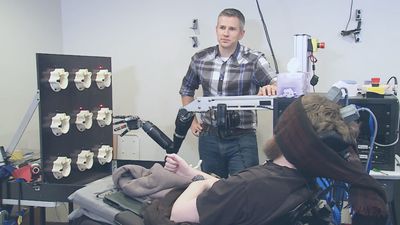You may not have heard of DARPA, the research branch of the Pentagon. But you're definitely familiar with some of the technology it has pioneered, like the Internet, Siri, and handheld GPS.
"Now we're going to try to go from this proof-of-concept all the way to commercial technologies that can powerfully affect patients' lives."
Last week in National Harbor, Maryland, DARPA celebrated its 60th anniversary by showcasing its latest breakthroughs and emerging research programs, one of which centers around using neurotechnology to enhance the capabilities of the human brain. This technology is initially being developed to help warfighters and veterans, but its success could have enormous implications for civilian patients and, eventually, mainstream consumers.
The field is moving ahead rapidly. Fifteen years ago, a monkey named Aurora used a brain-machine interface to control a cursor on a computer screen. In 2014, DARPA's mind-controlled prosthetic arm for amputees won approval from the Food and Drug Administration.
Since then, DARPA has continued to push neurotechnology to new heights. Here are three of their research programs that are showing promise in early human testing:
1) A NEURAL IMPLANT HELP MANAGE PSYCHIATRIC ILLNESS
More than 2.2 million veterans and 44 million civilians are living with some form of psychiatric illness, and medications don't work for everyone. DARPA set out to create new options for people living with debilitating anxiety, depression, and PTSD.
"We can get somebody back to normal. It's a whole new set of tools for physicians," said Justin Sanchez, Director of the Biological Technologies Office at DARPA.
He told the audience about a woman living with both epilepsy and extreme anxiety, who has a direct neural interface that reads her brain's signals in real time and can be modulated with stimulation. He shared a recent video of her testing the device:
"Now we're going to try to go from this proof-of-concept all the way to commercial technologies that can powerfully affect patients' lives," Sanchez said.
2) A NEURAL IMPLANT TO HELP IMPROVE MEMORY
"We are right at the cusp" of improving memory recall with direct neural interfaces, Sanchez said.
All day long, our brains shift between poor and good memory states. A brain-computer interface can read the signals of populations of neurons in the lateral temporal cortex. The device continuously monitors the state of the brain and delivers stimulation within a fraction of a second after detecting a poor memory state, to improve the person's memory performance.
The improved memory lasts only seconds, so the system "delivers stimulation as needed in a closed loop to keep the performance in a good state, because of this natural variability of performance," said Dan Rizzuto, founder of NiaTherapeutics, whose technology was developed with support from DARPA and the United States BRAIN Initiative.
Check out this recently shot video of a patient testing the device, which Sanchez called "a breakthrough moment":
About 400 patients have been tested with this technology so far. In a pilot study whose data have not yet been published, patients with traumatic brain injury showed improvement in recall of around 28 percent, according to Rizzuto.
He estimates that potential FDA approval of the device for patients with traumatic brain injury is still 7 to 8 years away. The technology holds the potential to help many other kinds of patients as well.
"We believe this device could also be used to treat Alzheimer's because it's not specific to any brain pathology but based on a deep understanding of the way human memory works," Rizzuto said.
3) A NEURAL IMPLANT TO REVOLUTIONIZE PROSTHETICS FOR WARFIGHTERS AND VETERANS
Since 2006, DARPA has run a program to revolutionize prosthetics. The latest advances allow amputees to actually feel again with their bionic limbs.
Sensors in a prosthetic hand relay information to an interface in the brain that allows the person to detect which of their "fingers" are being touched, while their eyes are closed:
WHAT COMES NEXT?
DARPA is now turning its attention to non-surgical, non-invasive neurotechnology. Researchers hope to use advanced sensor technology to detect signals from neurons without putting any electrodes directly inside the brain. Under the direction of program manager Dr. Al Emondi, the N³ program is about to launch soon and plans to run for four or five years.
"We haven't even scratched the surface of what a human brain's capability is," said Dr. Geoffrey Ling, the Founding Director of the Biological Technologies Office. "When we can make this a non-invasive consumer technology, this will explode. It will take on a life of its own."
Then, inevitably, the hard questions will follow.
As Sanchez put it: "Will society consider some form of neural enhancement a personal choice like braces? Could there be a disturbing gap for people who have neurotech and those who don't? We must come together and all think over the horizon. How the story unfolds ultimately depends on all of us."
Kira Peikoff was the editor-in-chief of Leaps.org from 2017 to 2021. As a journalist, her work has appeared in The New York Times, Newsweek, Nautilus, Popular Mechanics, The New York Academy of Sciences, and other outlets. She is also the author of four suspense novels that explore controversial issues arising from scientific innovation: Living Proof, No Time to Die, Die Again Tomorrow, and Mother Knows Best. Peikoff holds a B.A. in Journalism from New York University and an M.S. in Bioethics from Columbia University. She lives in New Jersey with her husband and two young sons. Follow her on Twitter @KiraPeikoff.
